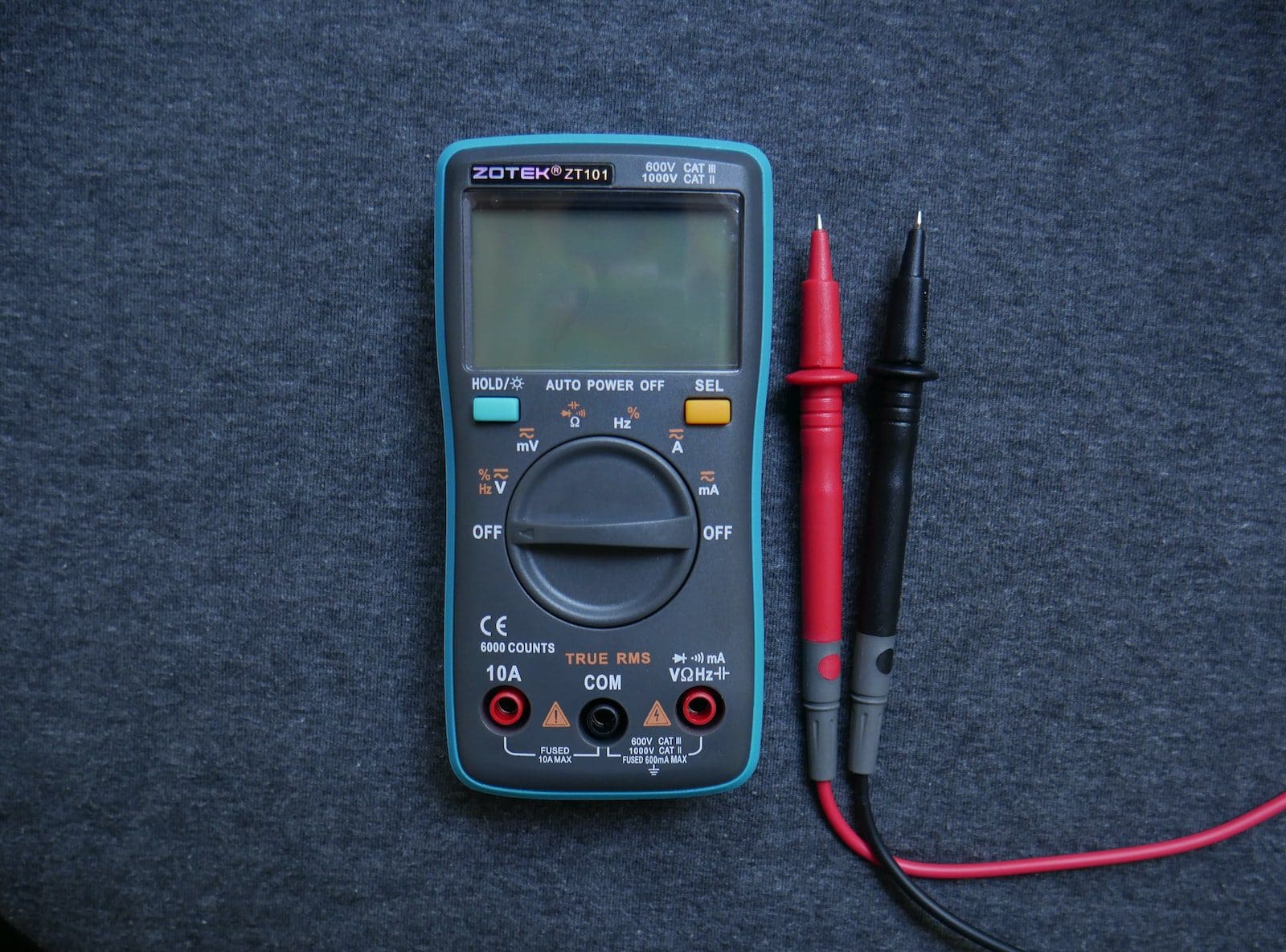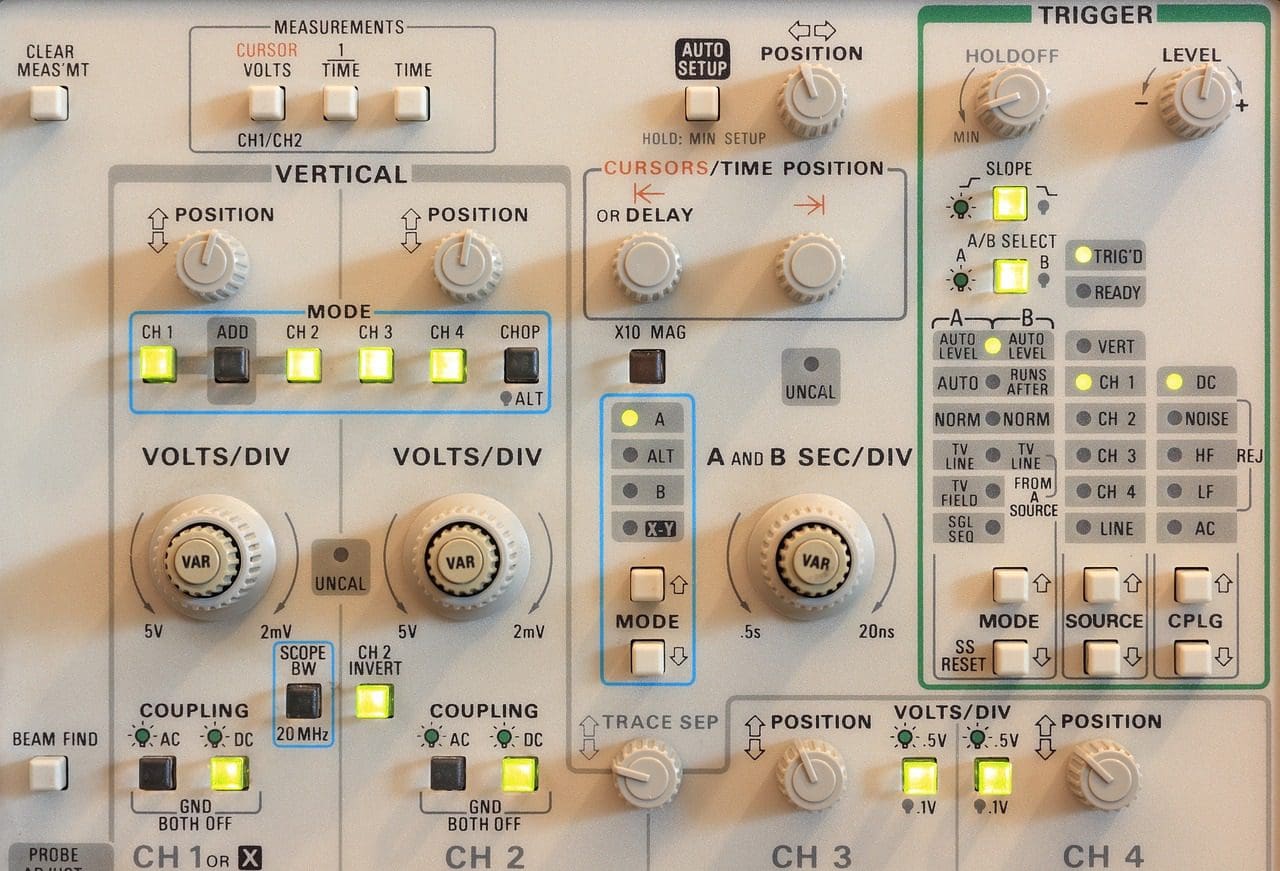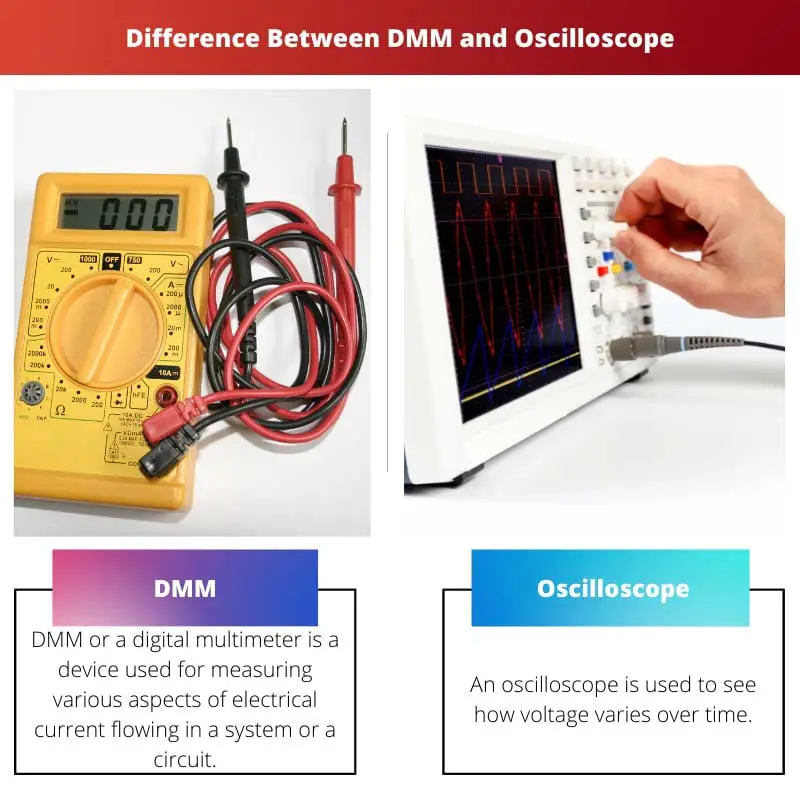It is critical to have the proper instruments while dealing with electricity to obtain reliable data and statistics.
The oscilloscope and DMM, which stands for Digital Multimeter, are two instruments that may be used to cope with electricity measurement as well as understand the magnitude of this resource.
A DMM and an oscilloscope have their own set of capabilities. The DMM is a flexible tool that can measure voltages, currents, and resistances and even verify the functionality of diodes and transistors.
Whereas an oscilloscope is used to monitor electrical voltage with utmost precision. And here goes the differences between them.
Key Takeaways
- Digital multimeters (DMMs) measure electrical properties like the voltage, current, and resistance, while oscilloscopes display waveform patterns of electronic signals.
- DMMs provide numerical readouts, while oscilloscopes generate visual representations of signal behavior.
- Oscilloscopes allow for real-time observation of signal changes, while DMMs only give instant measurements.
DMM vs Oscilloscope
The difference between DMM and an oscilloscope is that the oscilloscope can only measure the voltage of the current flowing, whereas a DMM is a more vital and multifunctional device that has the capacity to volts, resistance, and functionality of diodes. A volt-ohm-milliammeter (VOM) is synonymous with DMM.

A DMM or Digital Multimeter is an omnipotent device with lots of merits. It is widely used and has replaced the Analogue Multimeter because of its ease of usage and accuracy.
Although, when compared to an oscilloscope and the condition is the measurement of electrical voltage, the oscilloscope does a better job than the DMM. A consecutive approximation register is a concept utilized in analog to digital conversion (inside the DMM).
The sequential approximation record ADC works by gradually homing in on the value of the input voltage, as the name indicates.
An oscilloscope, on the other hand, is a much more precise and costly instrument used by professionals and hobbyists only. It’s a very important tool for measuring the voltage and accurate change in current flowing.
The oscilloscope can accomplish something that the DMM can’t: it can look at how the voltage varies over time. When it comes to electronics and signal inspection, this is quite beneficial. One can readily find out whether the voltage is in the shape of a sine wave, a sawtooth, or a square wave.
Comparison Table
| Parameters of comparison | DMM | Oscilloscope |
|---|---|---|
| Functions | A digital multimeter is a tool for measuring discontinuous signals accurately, but it cannot display waveforms that reflect signal intensity, nor can it show transient or harmonic signals that might damage the balanced circuital system. | An oscilloscope is used to measure the voltage of the electrical supply. When it comes to the presentation of measured data, the oscilloscope outperforms the digital multimeter. |
| Measuring units | It measures the units namely; ohms, Hertz and Volts. | Since it measures the voltage of current flowing, the unit is Volts. |
| Effectiveness | It is a really handy and efficient tool used by electricians. Some multimeters can also measure the temperature. E.g. OWON, B41T. | It is a precision-centric professional device that gives out the output in its display panel. The panel includes a graph of the measured signal of the voltage The vertical axis represents voltage. The horizontal axis represents time. |
| Cost | Ranges from 1500 INR to 17,800 INR. | The difference in cost between a DMM and an oscilloscope can be more than 9 times. It ranges from 50,000 INR to 58,000 INR. |
| Other names | Volt-ohm-milliammeter (VOM). | A-scope or O-scope, CRO (for cathode-ray oscilloscope), or DSO (for the more modern digital storage oscilloscope) |
What is a DMM?
DMM, or a digital multimeter, is a device used for measuring various aspects of electrical current flowing in a system or a circuit. DMMs are extremely omnipotent and flexible tools that can measure voltages and resistances and even test the functionality of transistors.
However, the digital Multimeter is a more precise and accurate successor of the analog multimeter.
Only amps, volts, and ohms could be measured with an analog multimeter. But, with the development of integrated circuit technology and other technologies, analog to digital converters and other devices such as display screens (LCDs) became possible.
This allowed test equipment to be created that could digitally measure the fundamental metrics of amperage, voltages, and resistance. Hence the device stands as an all-rounder device to operate a circuit and find out electrical leakages as well.
The operation of a DMM consists of four main connections or probes that can be understood from the given points below. Also, these probes require accurate connections to produce the results in the display panel.
- Common – This will accept the negative or black lead and probes for all readings.
- Voltage and frequency – This connection accepts the positive or red lead and probes that are used for basic tests.
- Amps and milliamps – One such interconnection is used to measure current and will accept the red lead and probe once again.
- Higher current – for large voltage measurements, there seems to be a separate connection. If high power levels are expected, this should be used instead of the low current connection.

What is an Oscilloscope?
An oscilloscope is used to see how voltage varies over time. Indicators are voltages that are used to communicate information, such as an audio signal that plays music on a microphone or a speaker.
The differential magnitude of the voltages using a graph is one of the things that an oscilloscope’s display screen shows. The vertical axis represents voltage, while the horizontal axis represents time.
The USP of the oscilloscope is the process of comparing two voltages by plotting them together on the same screen. So, if you have an intake and an outlet, you can put them both on the screen to examine whether the circuit has changed promptly or not.
The monitor of an oscilloscope will allow you to check whether your circuits are functioning properly. It will also help you discover any issues with your network, such as unwanted signals known as noise.
There are three types of oscilloscopes. They are explained briefly below, along with the names;
- Digital storage oscilloscopes (DSO): A digital storage oscilloscope is the same as the digital oscilloscope with minuscule differences, i.e. Instead of the bright phosphor present in the analog versions, it uses a raster-type monitoring device.
- Mixed-signal oscilloscopes (MSO): An RF spectrum analyzer is used with an MSO or DPO in a combined or Mixed domain oscilloscope (MDO) to provide correlated views of signals from the digital, analog, and RF domains.
- Digital phosphor oscilloscopes (DPO): The digital phosphor oscilloscope (DPO) takes a fresh look at oscilloscope design. It can provide distinct collecting and display capabilities to properly reassemble a signal thanks to its design.

Main Differences Between DMM and Oscilloscope
- A DMM is considered as a compact tool for electricians for measurement of circuit failures, voltage, resistance, etc., whereas an oscilloscope is only used for measuring current difference, aka voltage.
- A DMM is cheaper, whereas an oscilloscope costs 10 times more than that.
- DMM can be used by anyone because of its multipurpose but an oscilloscope’s graphical output can only be studied by professionals.
- DMM is also known as Volt-ohm-milliammeter (VOM), whereas an oscilloscope is called an A-scope or O-scope.
- A DMM cannot measure waveforms or types of waves, but an oscilloscope can.

- https://www.electronics-notes.com/articles/test-methods/meters/dmm-digital-multimeter.php
- https://www.sciencedirect.com/topics/engineering/digital-oscilloscope

Digital multimeters and oscilloscopes have their own set of capabilities which are important for understanding electrical measurements.
Indeed, both the DMM and oscilloscope play a vital role in accurately measuring voltages, currents, and resistances in electrical systems.
The detailed comparison of DMM and oscilloscope provides valuable insights into the functionality and precision of these instruments for electrical measurements.
Absolutely, the comparison helps in understanding the unique strengths and limitations of DMM and oscilloscope in electrical measurements.
The detailed explanation of DMM and its precise capabilities highlights its role as a versatile instrument for measuring electrical aspects.
Absolutely, the versatility and flexibility of DMM make it an indispensable tool for accurate and reliable electrical measurements.
I completely agree, the in-depth analysis of DMM underscores its ability to handle various electrical measurements efficiently.
The detailed explanation of DMM and its operation provides valuable insights into its precision and capabilities for electrical measurements.
I agree, the detailed explanation helps in understanding the device’s utility in accurately measuring various electrical aspects.
The detailed comparison table provides a comprehensive overview of the functions, measuring units, effectiveness, and cost of DMM and oscilloscope.
Indeed, the comparison table serves as a valuable reference for assessing the suitability of each instrument for specific electrical measurement needs.
Absolutely, the detailed comparison table simplifies the understanding of key differences between the DMM and oscilloscope.
Understanding the role and operation of DMM in measuring electrical current flow is crucial for effective and accurate circuit operations.
Absolutely, the precision and accuracy of DMM are essential for ensuring reliable results in electrical circuit operations.
The comparison between DMM and oscilloscope sheds light on the precise capabilities and costs associated with each instrument for electrical measurements.
I completely agree, the comparison enables informed decision-making regarding the selection of instruments for electrical measurements.
Indeed, the comparison helps in evaluating the suitability of DMM and oscilloscope based on specific requirements and cost considerations.
The oscilloscope and DMM are critical instruments when dealing with electricity measurement to obtain reliable data and statistics.
Absolutely, understanding the capabilities and differences between a DMM and oscilloscope is crucial for accurate electrical measurements.
I agree, the insightful analysis of these instruments is essential to ensure accurate results in electrical measurements.
The detailed comparison of DMM and oscilloscope highlights the differences in their measuring units, effectiveness, and cost.
I completely agree, understanding these aspects is crucial for selecting the right instrument for electrical measurements based on specific requirements.
The comparison between DMM and oscilloscope helps in understanding their functions and effectiveness in electrical measurements.
Absolutely, the detailed comparison provides valuable insights into the capabilities and limitations of each instrument in electrical measurements.